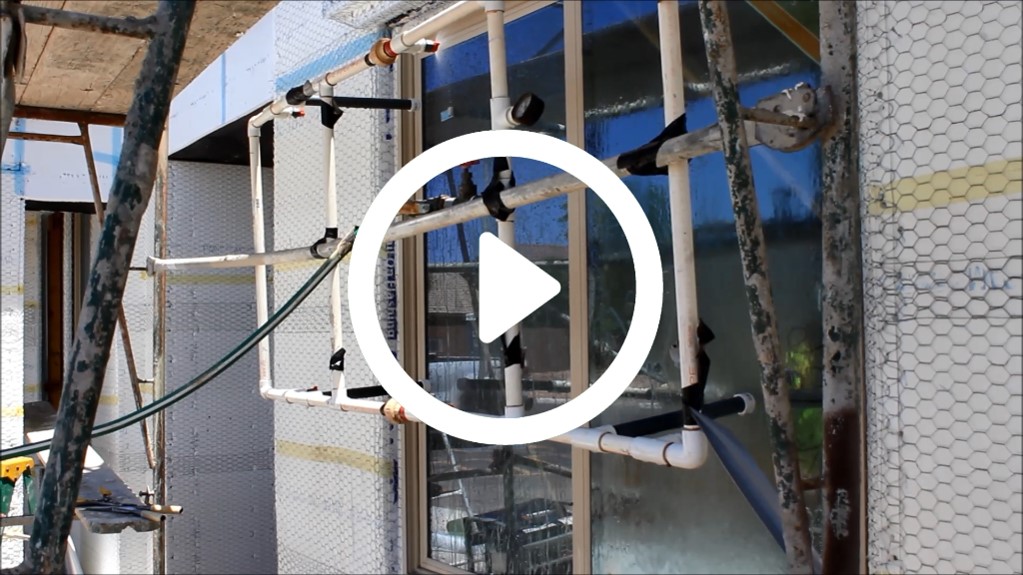Water Intrusion is the Largest Generator of CDL Claims and Insurance Losses
Click on the video to see what it takes to perform a water test on a window!
During our 20+ years of experience in the construction industry, Quality Built, LLC has compiled a database of over 2,000 notable construction defect litigation (CDL) cases. Of these cases, the majority of them were linked to water intrusion. Such circumstances occurred at the windows, at the weather resistive barrier, at the exterior cladding of a structure, through roofs, or at decks. Knowing the extent of risk-potential tied to water intrusion in buildings, the Quality Built team made a point of gathering a knowledgeable and experienced staff averaging 25 years of inspection experience to perform forensic water testing inspections in order to help mitigate builder risk and insurance losses across the country.
Why Engage in Water Testing?
Although the components of a structure may appear to be installed correctly to the naked eye, even the slightest gap is susceptible to water intrusion. Homeowners expect their homes to be built flawlessly, and if their windows begin to leak, they are likely to become extremely upset and even seek to sue parties responsible for the cause of damages. Oftentimes, the location of the leak is not consistent with the source of where the water seems to be penetrating the structure. Without testing and isolating the source of the issue, contractors are likely to repair the wrong mechanism and thus fail to eliminate the water intrusion problem altogether.
Forensic testing and inspection is the practice of using scientific methods to gather evidence. Forensic testing is more commonly associated with the scientific testing to gather evidence when a failure of an assembly is believed to exist. For these conditions, the forensic testing and inspection attempts to identify the method and extent of failure, and formulate the best method to repair and remediate the failure on a case by case basis. Forensic testing performed before and during construction is often referred to as field testing. At these stages, the testing and inspections identify components that are susceptible to water intrusion and gather evidence of whether they will perform as intended or if they will allow water intrusion to occur.
When Water Testing Should be Done - Projects and Stages
All projects can benefit from water testing. The stage in which the testing should occur varies depending on the type of construction that is taking place. Most projects can benefit from the construction and testing of mock-ups, both to validate the planned installation procedures, as well as to provide a place to demonstrate the expected installation procedures to the personnel involved in the assembly.
It is recommended that projects engage in water testing of random windows assemblies at two stages of the building process:
- Following the installation of windows and the weather resistive barrier.
- After installing the exterior cladding.
Additionally larger projects can benefit from the construction and testing of a mock-up of the window and wall assembly prior to the start of construction. This will help to verify that the as-designed system will perform as anticipated and help the installers to work out the installation methodology.
It is essential that water testing begins following the installation of windows and the weather resistive barrier, as at this stage in the process it is easiest to identify and remediate any sources of water intrusion. Once the exterior cladding is installed, it is much more difficult to make repairs, changes, and alterations to the assemblies. Although repairs made after installing the exterior cladding will be more intrusive and costly, it is still important to perform testing at this stage, as this will allow one to ensure that the install did not cause any alteration of the system that could eventually lead to a constructive failure.
QA vs. QC
(VS)
For example, QC is the testing of a window to determine if it performs as intended. QA is the process of looking at all of the elements that go into installing the window to ensure it performs as intended, including but not limited to:
- Checking of the details to verify they will result in a weather-proof assembly.
- Ensuring the contractor has a process to verifying the installer is trained, competent, and knowledgeable about the products to be installed.
- Verifying that the selected window product is certified by a testing agency for water penetration resistance.
- Inspecting the installation to confirm it appears to provide a weather resistive condition.
- Confirming processes are in place to address any non-conforming issues.
- Using information collected to improve processes.
AAMA/ASTM Water Testing Process
Below is a simple description of a test procedure based on AAMA / ASTM test standards:
- Select a test location
- Remove interior finishes (if applicable)
- Construct a chamber
- Hang the calibrated spray-rack
- Depressurize to a pressure differential based on either the rating of the window, or in a forensic case, depressurize to a pressure that mimics the weather condition of when the leak occurred
- Turn on the spray-rack and test for the appropriate time period.
- Document results
QB Recommendations
Forensic testing is part of a Quality Control program that Quality Built would recommend builders consider adding to their overall Quality Assurance program. These tests can be part of a complete water proofing consultation services package or even act as a stand alone function. However, an affective and complete water proofing consulting service is optimal, as it incorporates quality control testing performed either by the consulting firm or at the very least observed by the consultant. Quality Built can offer complete water proofing consulting services, including performing the forensic testing itself. All of this is geared towards lowering the risk for our clients. Such consulting services and especially the testing is strongly recommended for high risk assemblies including recessed windows and water proof decks over habitable space. Additionally, with the increasing emphasis on energy codes we are seeing, we believe that new risk will begin to surface, therefore making the testing of the building envelope more vital on projects to come. Please contact us for more information or to discuss your upcoming projects and what testing may be recommended to help reduce your risk.
ABOUT THE AUTHOR
Jeff Hoch is a licensed architect and has been involved in the construction industry for over 27 years. He has a passion for safety and strives to educate the industry about building best practices and risk mitigation techniques. Jeff is constantly taking part in educational seminars and is extremely knowledgeable when it comes to building code requirements. Jeff performs inspections all across the nation and specializes in forensic inspections, AAMA/ASTM water testing, technical peer plan reviews, quality assurance, and much more. He also is extremely experienced with design standards, local ordinances, forensic building failure analysis, and construction defects.
You can reach Jeff at: mailto:[email protected]



